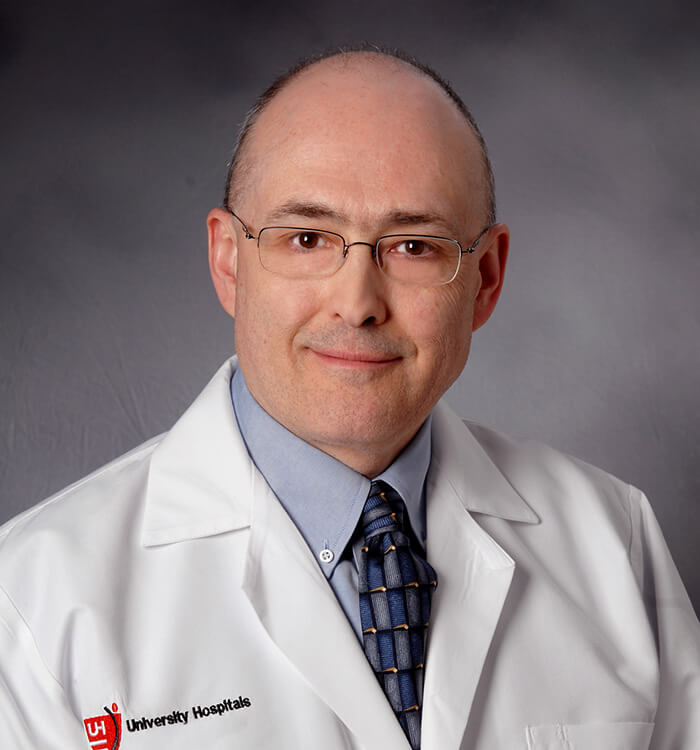Helping Patients Stay Healthy in the University Hospitals System
March 31, 2022
UH Clinical Update | April 2022
Ray Bermea, MD, a recent “Dinner with the Doc” honoree, helps UH physicians map out achieving care retention and population health goals to benefit their patients
Ray Bermea, MD, is a recent “Dinner with the Doc” honoree, cited for his commitment to value by leading the evolution from Clinical Integration and UH Population Health to the Provider Value Network (PVN), guiding strategists who offer an optimized level of assistance to primary care practices around the UH region.
 Raymond Bermea, MD
Raymond Bermea, MDHis partnership and support of his own PVN staff were one of several characteristics mentioned when he was nominated, as were his championing of systemness, patients, and overall quality and process improvement.
Dr. Bermea leads a change that starts with culture, then affects people, processes, and technology.
After joining University Hospitals in 2012, Dr. Bermea was appointed a medical director of UH Clinical Integration in 2015. He is responsible for UH’s west region, while Paula Deuley, MD, is medical director of the east region.
At that time, Clinical Integration had a team of physician liaisons, who worked with primary care offices throughout Northeast Ohio. The emphasis then was on urging the physicians and their staff to refer their patients to UH specialists instead of outside the system, and to perform Point of Service scheduling – making follow-up and specialist appointments before the patient left the office.
Six years later, those have become more ingrained habits, but the physician liaisons – now called provider value network strategists – work with primary care physicians in a more comprehensive way.
As a medical director, Dr. Bermea leads by example. His staff say he takes time out of an incredibly busy schedule – one in which he still see patients three days a week at his Fairlawn office – to meet with leaders, team members, practice staff and providers to help improve value.
His work with the team has been referred to by one of them as a “master class” in emotional intelligence, as he focuses on how to support the practices and providers, and the “why” of change.
As Dr. Bermea explains, “Physician liaisons have gone from outreach to looking at hard data, and they will have deep conversations on care retention. For example, they know that if a patient needs a cardiologist, it’s better for their care to stay within the quality, safety and consistency our system has.
“And if a patient was referred outside the system, they will ask, “What were the drivers?”, whether it was cultural, for example, or if it was because the patient didn’t want to travel a much longer distance.”
Dr. Bermea is familiar with factors, because his Fairlawn office is located in a region where UH doesn’t have as many resources as elsewhere in Northeast Ohio. So he engages with provider colleagues in the Summit County area who may be struggling to connect patients with UH services, and who may have taken the path of least resistance by simply referring outside the UH network. Because he shares those challenges, he is able to relate and encourage them to go the extra step and recommend a UH provider to their patients, even when the distance is further.
He also has educated himself and his colleagues on Quality Care Network (QCN) providers, helping the team understand how a QCN provider can have an impact on care retention and quality for UH.
“It’s looking closely at what options we have out there, and if we have a weakness of a service line in a certain region, that information has to funnel up to our leaders,” he explains.”
But the PVN team’s focuses on much more than care retention. It also emphasizes physicians meeting the population health metrics driven by Medicare, and how well UH as a system does to make sure that patients get necessary screenings, including mammographies and colonoscopies. That means team members have had to acquire a new skill set, one based and measured by hard data. Drs. Sona Kirpekar and Todd Zeiger have led educational sessions for the team on those topics.
“It’s also about observing how practices function, and making them more effective – it is about data and how you apply it,” Dr. Bermea says.
He himself was willing to dive into and embrace Solver market data. He helped the team develop Care Retention action plans based on ACO data, and then, based on his perspective, guided them on how to successfully share data with physicians.
“As a practicing physician, Dr. Bermea is a true clinical asset who faces the same challenges as the offices our team calls on daily,” says one of his team members in the nomination form. “He’ll even go out into the field with us to advise practices on how they can improve care retention, POS and population health metrics.
“Not only is he an excellent instructor on our many data systems, he has an amazing awareness and history of the many practices in the surrounding markets."
As another team member put it, “Dr. Bermea truly embodies UH’s values gracefully in every interaction and leads with compassion, grace, and professionalism.”
Congratulations to Dr. Bermea on his “Dinner with the Doc” honor.


